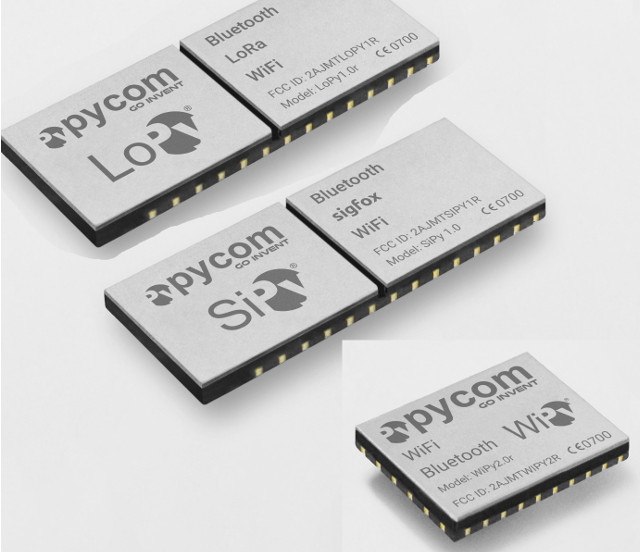Pycom is the company making some relatively popular IoT boards programmable with Python such as WiPy, LoPy, SiPy, and soon FiPy, supporting respectively WiFi+BLE, LoRa+WiFi+BLE, Sigfox+WiFi+BLE, and for the latter all four plus LTE CAT M1/NB1. Those little boards are great for personal projects and/or to experiment, but for those of you who would like to integrated IoT connectivity into your own hardware projects, Pycom will soon launch three OEM module for corresponding to WiPy, SiPy and LoPy connectivity featues with respectively W01, S01 and L01 modules.
- W01 WipY 2.0 OEM Module – Dual network BLE and WiFi – 7.95 Euros
- L01 LoPy OEM module – LoRa, WiFi and Bluetooth – 14.95 Euros
- S01 SiPy OEM module – Sigfox, WiFi and Bluetooth; Available in both 14dB (for Europe) and 22dB (outside Europe) version for respectively 14.95 and 19.95 Euros
All three models have basically the same functionality as the full board, but there are missing the voltage regulator, reverse power supply protection, antenna switch, smd antenna, u.fl connectors, reset switch, LED, headers, and a few passive components found on the development boards. The modules will come in an hermetically sealed trays, and are both CE and FCC certified.
The modules will officially launch in April 2017 with a minimum order quantity of 500 units, and a lead time expected to be 8 to 12 weeks. You can find all three modules on Pycom’s OEM products page.

Jean-Luc started CNX Software in 2010 as a part-time endeavor, before quitting his job as a software engineering manager, and starting to write daily news, and reviews full time later in 2011.
Support CNX Software! Donate via cryptocurrencies, become a Patron on Patreon, or purchase goods on Amazon or Aliexpress. We also use affiliate links in articles to earn commissions if you make a purchase after clicking on those links.





When you look on the Sigfox site, you immediately see a ‘Coverage’ link which shows a rough coverage of ‘Live’ & ‘Rollout’ areas for all of Europe, and below a list of countries around the world that have a Sigfox Network Operator (SNO).
I cannot find a comparable site for LoRa to show service providers for each country. When I email LoRa-alliance.org to ask for such, their reply does not have. Does that mean there are no IoT Network Operators allowing private users to economically connect a IoT node to the Internet ?
If there are IoT Network Operators in various countries that can act as a more economical bridge between a LoRa node and the www than existing 3G phone operators, does anyone know any sites that list them ?
@paul
There are a few listed at https://lpwanmarket.com (see Platforms) but beware most LoRa services are still in testing/trial phase
@paul
LoRaWan is also a bit different since anybody can setup their own gateway cheaply.
A $50 LoPy board can be configured as a Nano-Gateway with up to 5 km range supporting up to 100 nodes. It relies on LoRaWan for connectivity with sensors, and WiFi for connectivity to your WiFi router.
Some also join the community based “The Things Network”, and I understand you get coverage for free if you are part of the community (TBC).
One only issue with that is for moving assets that you want to track, for example a LoRaWAN GPS tracker for your car in which case a commercial network would really be useful.
@cnxsoft
It’s not really that simple. First LoPy doesn’t actually offer that functionality yet (it just barely does regular LoRaWAN now) and the 5Km figure is very much exaggerated, you’ll struggle to get even 1Km if the nano-gateway is indoors.
Yes, anyone can connect to the Things Network (no need to be part of the community) but it’s still very much experimental and most gateways – €250+ a pop – are indoors so again range claims have been greatly exaggerated.
For example I was recently in Zurich – the city which lists the most Things Network gateways – and never once got a connection other than when I was in the exact same building as the gateway.
The final kicker is – even considering LoPy will one day make the nano-gateway functionally work – €50 is still more than an year’s worth on GPRS ‘IoT’ data – and 10 years of Sigfox – so unless you’re running many nodes (which you can’t because nano-gateway is limited) it’s all rather pointless.
Also you can buy GPRS modules for less $$$ than LoRa ones: Minimum for LoRa (@868Mhz) is about $8 while GPRS is $6 and Sigfox modules are now <$3
So I think it makes a lot of sense for commercial – high quality – LoRa operators and services such Sigfox for far more applications that just "moving assets". For many users simply doesn't make any economical sense to be running their own gateways.
@JM
Many thanks for your illuminating but sad advice about current lack of LoRa Network Operators to allow a link between a IoT node and the www, and comparative pricing of access hardware between Sigfox and LoRa. I also thought it offputting to expect small private customers who want to connect a small IoT node to the internet, to have to incur design expense/time making own access hardware to avoid vast expense renting a wideband 3G connection
I followed up your suggestion to check lpwanmarket.com. Their home page had a link to ‘Network Operator List’ but sadly greyed out so sent email enquiry. Got reply end of December saying they were promised a list of network operators by the LoRa Alliance for a long time now but still do not have this information. Unlike Sigfox, it would appear LoRa Alliance not interested in furthering low-data rate IoT node connections to the www as a more economic alternative to 3G networks or Sigfox. Sigfox told me as of now, coverage just 1 or 2 miles short of my UK and Brazil locations.